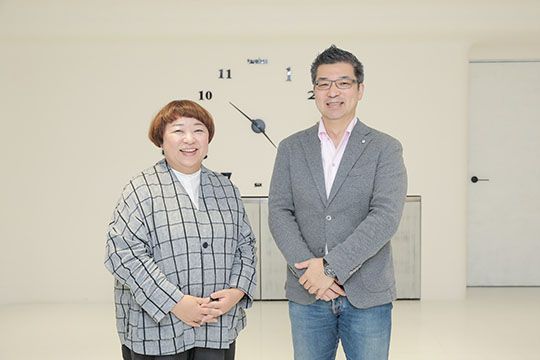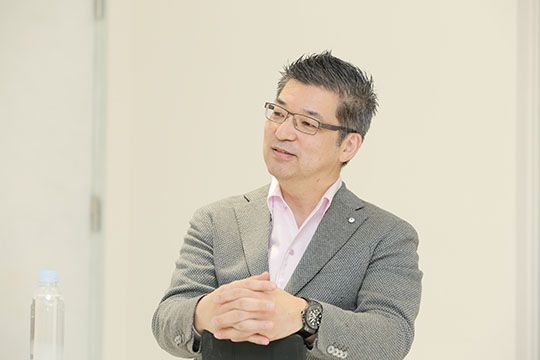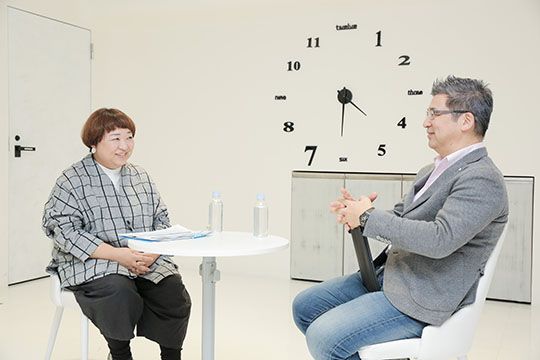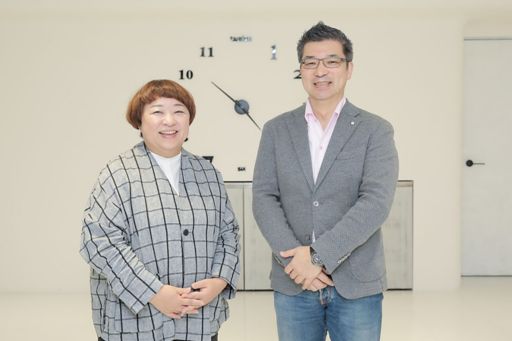Teleworking has become widespread due to the COVID-19 pandemic and communication in the workplace has changed considerably compared to the past. This trend will undoubtedly accelerate going forward. One direction of the trend that is attracting attention is the "metaverse," in which people interact by constructing a digital three-dimensional virtual space.
In such a situation, how will human beings weave relationships with each other going forward?
In this article, we will introduce the discussions conducted between Natsuko Yamada of Shigoto Soken Inc., who continues to practice team building in the essential sense by using graphic facilitation, and Masayuki Chatani of KPMG Ignition Tokyo. During these discussions, they envision and fantasize how to weave workplace relationships in the post-COVID-19 era and how communication and technology should be used 50 and 100 years from now.
Contents
- Link to Vol. 1
- Can Anyone Draw a Picture of the Atmosphere?
- How to Change Communication beyond the COVID-19 Pandemic?
- Segregation of Situations where Efficiency and Non-efficiency are Important
- Segregation of Real and Digital Considered from Perspective of "Efficiency of Failure”
- Using Technology as a Tool to Help Each Other
- Profile of Interviewee
Can Anyone Draw a Picture of the Atmosphere?

(Natsuko Yamada, CEO of Shigoto Soken, Inc. (left), Masayuki Chatani, Representative Director & CEO of KPMG Ignition Tokyo and CDO of KPMG Japan (right)) *Professional affiliation and official position in the article are at the time of publication.
Chatani: I would very much like to ask about your communication style. You mentioned that when you do graphic facilitation, you draw a picture of the atmosphere around you. It seems like it requires a very advanced skill and, in a way, it’s something "only you can do.” Does that mean that graphic facilitation is not something that can be done by just anyone?
Yamada: I don’t think it’s that special. I feel that it’s just a matter of whether or not we can use our "sensitivity," which we possess as a means to survive, and whether we consciously use it or not. However, if we try to capture the feelings of everyone in a crowded train, for instance, that would be too tiring. It is therefore important to exercise our "sensitivity" by increasing its level at facilitation opportunities while letting it go at other times.
Chatani: I see. However, I imagine that even if you can perceive the atmosphere and the mood of the place with high sensitivity, you may not be able to share it with everyone unless you have the ability to draw pictures (in a pictorial sense).
Yamada: The reason why people are concerned about whether or not they have an artistic sense and can draw pictures may be the "art" classes in school where they were "evaluated" and judged by teachers on whether they were good or bad at drawing. However, I want to say out loud, "Please don't worry about that!"
Even if you feel that you are not good at drawing or have never held a pen or paintbrush before, people who can feel with their hearts will create very good drawings that are simple and touching. I have seen such drawings many times in the past. I think it depends on how much the subject is received with care in your heart.
This doesn’t apply only to drawing, but through our experience of being evaluated many times in the past, we tend to make judgements such as “I can do this but I can’t do that. I’m good at this but I’m not good at that.” However, what is important is the accuracy of your sensitivity—the power of observation and insight—which is an important skill to have in order to survive. As for drawing, the answer cannot be determined without trying to draw something. It’s only when you try to draw something that you can realize whether what you have just observed was wrong.
The reason why I’m glad I studied art is that I was able to hone my observational skills and learn that things look different depending on the angle, posture, and height of the viewer's eyes through drawing pictures. In this sense, I think that if everyone tries to "observe things from different perspectives" on a daily basis even from now, they will be able to view people in a kind way and weave relationships with them.
How to Change Communication beyond the COVID-19 Pandemic?
Chatani: I assume that many of you are aware that the COVID-19 pandemic has increased the number of areas that seem different to the senses from the past. Even at KPMG Ignition Tokyo, there are more people who joined the company during the COVID-19 work-from home period.
There are cases where these people rarely come to the office after joining the company and have few opportunities to meet with people outside their team.
In such cases, there are concerns that while they have a sense of belonging to a project, their sense of belonging to a larger unit such as the company organization may become diluted.
In the past, serendipitous interactions were easily generated when people came to the office to work and greeted each other or engaged in brief chats triggered by their belongings or the pattern of their clothing when they happened to pass each other in the corridor or break room.


However, this is difficult to reproduce when working online. As it has become difficult to take further steps and "bring the conversation from chats to consultation," we are now thinking of ways to solve this problem with technology
I’m assuming that this is an issue at other companies as well.
I think that this is why technology-driven companies such as Facebook (Meta Platforms, Inc.), Microsoft and Adobe are exploring the possibilities of the metaverse and accelerating their transition into cyberspace.
I think that the importance of graphic facilitation, which you are doing, will therefore increase. What form do you think graphic facilitation will take when it is based on the premise of cyberspace?
Yamada: I have had many opportunities to think about this myself, as I have been working online as much as possible, including team-building workshops.
It would probably be cool to use a digital tool to draw a picture when we have an online discussion, because what the participants are talking about becomes a picture on the spot and can be shared with each of them. However, I have decided for myself that “I will never draw with digital tools, even when facilitating online discussions.”
This is because I feel that we can create trusting relationships only when “people’s stories are taken in and portrayed by people.”
As we can only use our visual and auditory senses when discussing things online, it’s difficult to convey responses such as, "I have taken in what you said now," through a screen. This is why I think it’s even more necessary to draw a picture on a piece of paper while sweating when doing graphic facilitation online to convey that we are taking in what is being talked about with our whole body.
Without such an analog sense of feeling, I believe that those who are speaking will not feel that “what they talked about has been taken in.”
I want to do whatever I can in an analog way. Also, even in a digital space, I think people will be emotionally moved when they see themselves reflected and hand-drawn in a picture. I’m insisting on being stubborn in this area (laughs).
Chatani: I can relate to that very much. I do calligraphy but I feel incomplete when I write with a digital brush pen. I think this is because I’m missing the "noise" of writing with a brush that I usually use, such as the unevenness, the disproportion of the brush tip and the care I take not to lose any hairs from the brush.
In real life, you have to write letters and finalize some kind of work while controlling these noises. This is where the analog feeling, or the blank space, or something contingent like that is born. You can add to the work later when you are working digitally, but it is very difficult to reproduce the accidental atmosphere, the turbulence of the ink, and the splashes created by the momentum of the ink.
When you watch calligraphy teachers, they sometimes intentionally drop ink before placing the brush on the paper. This becomes part of the scenery or technique of the work. I think that nuance, tone, and some sort of "face" behind the words are actually really important even for words that exist in a real space. I feel that this serves as a kind of spice that persuades the receiver of the communication.
It’s difficult to realize this in cyberspace but it’s something I’m looking forward to.
Yamada: Digital tools were originally created to improve efficiency. However, if various important elements are contained in the parts that cannot become efficient, I think it would be a good idea to create "something" in digital tools that cannot become efficient or stops efficiency.
For example, in group homes and facilities for the elderly, a little "inconvenience" is intentionally created by building steps so that the elderly won’t lose their muscle mass. Just like this idea, I hope that digital technology will be developed in the future by placing intention and value where convenience and efficiency are not sought.
Segregation of Situations where Efficiency and Non-efficiency are Important

Chatani: Digital technology that does not overly pursue efficiency may be one of the trends of the future.
Yamada: After all, many business people are speed oriented and always seem to be in a rush. They try to work very hard while saying, “I have to deliver outcomes. I have to get results. I have to advance.” However, if we really want to do something by involving everyone, I think that it’s very important to pause and think, "I wonder what's behind those words you just said?” or “I wonder what’s going to come out of the little discomfort being felt here now.”
So, graphic facilitation is doing the exact opposite of promoting efficiency by deliberately showing what has been drawn to get people to “pause.” Because meetings and discussions are done in this way, conclusions are not reached quickly or clearly. Rather, I try to create an opportunity for everyone to pause and think deeply about this ambiguity or fuzziness.
It would be nice if that element could work in digital technology as well.
Segregation of Real and Digital Considered from Perspective of "Efficiency of Failure”
Yamada: As you introduced a little earlier, I’m also involved in the training of graphic facilitation professionals. In such a situation, I feel that “failure is also becoming more efficient” with only online education.
When I was teaching and training students face-to-face and made a mistake, I would go out for a drink with the class members afterward where we would talk and our discussions would expand to “what it was that went wrong.” However, I feel that today's failures tend to end up within the individual.
I think online tools are quite powerful for bringing out and developing individual abilities, but in terms of connecting teams and weaving relationships, I think we still need to think about letting go of making things more efficient.

Chatani: The story about failure becoming more efficient is an interesting point.
What is slightly similar to that idea is the need for a "wall-hitting AI to nurture professionals.”
KPMG is a professional firm, but with the development of AI, the process of developing the foundation of the professional part of auditing and accounting professionals can be replaced by AI. Therefore, there may be cases where people can proceed with their work and become veterans without going through the part they had traditionally experienced.
Many things will eventually be done by AI and, in fact, I have already created my own digital twin to give speeches and make presentations at conferences. I have come to see the advantages of a digital twin. For instance, it reduces the burden of having to make the same speech again or I only have to update the revised parts of a speech manuscript even if there is a change.
Yamada: Because we can do such things, I think the meaning and value of what should be done in real life or in person will change, or what should be done in person will be scrutinized. I assume that there will be a stricter distinction going forward such as using online video distribution and information provision for situations that only require one-way information provision.
Using Technology as a Tool to Help Each Other

Chatani: Now, this is my last question. In what direction do you think graphic facilitation will move and what role do you think it will play in 50 or 100 years,?
Yamada: In 50 or 100 years from now?
I’m usually involved in organizations where there is "distortion," in other words, where people are arguing with each other. However, I feel that such "distortion" is largely caused by the gap between the speed at which digital technology and civilization are evolving and the lagging pace at which human awareness is changing and evolving.
Given this, I think that by clearly separating what can be done in an analog way, what can only be done in an analog way and is valuable because it is analog, and what can be done digitally—for example, realizing mass production while maintaining constant quality—we will be able to reduce the conflicts that are occurring today. We need to leave to digital technology what can be done digitally and focus more on what only humans can do that requires sensitivity and sensuality.
Chatani: If technology were to give assistance in this area, what could it do?
What it can do, which is often talked about, is to conduct a survey within a company to quantify and measure the results. While this in itself is one approach, there may be some doubts about the accuracy of the results, as the answers are socially sensitive and so the true feelings of the respondents are not expressed straightforwardly.
However, I imagine that when we’re faced with something that cannot be quantified, there will be people who would say, "Let's quantify it and clarify the degree of team building achievements and capability values.” What are your thoughts on this?
Yamada: In fact, there are many companies that are carrying out internal surveys, and sometimes we receive requests from them, such as, “The team building score was not good, so can you do something to raise it?”
When I receive such requests, I try to ask, "So, why do you want to increase the value of the relationships, in other words, why do you think that the relationships are important?"
This is because it is important to clarify the difference between whether they want to raise the numbers because they have been told that these numbers are important, or because they sincerely believe that “this work cannot be done well without good relationships, and we want to improve it.”
This will lead to confirming whether a situation has been created in the organization where questions such as “why do you want to do this job?” or “why does this company still exist in this world?” make sense to the people who are working there.
As is the case with digital transformation (DX), which is much talked about these days, I believe that our aim should not be to promote DX but that we must confront the theme of "how to use digital tools based on what kind of vision and hopes for the future.” I feel that the time to undergo a paradigm shift, where we need to change the company and the way we work for the sake of people rather than changing people for the sake of the company, has already come right before us.
Up to now, technology can be seen to have played a role in "improving efficiency to win in the competition" or "increasing speed."
However, from now on, I hope that the discussion will shift to how we can use technology to help each other rather than for competition, and I believe that it would be better to place an emphasis on this area.
Profile of Interviewee


Natsuko Yamada
CEO of Shigoto Soken, Inc.
Representative Director of the Graphic Facilitation Association
Natsuko Yamada is an Organizational Development Facilitator/Creative Facilitator/System Coach. After graduating from the College of Art and Design, Musashino Art University, Natsuko Yamada joined Vantan Inc., which operates training schools for creators, where she served as the school director and a director of various schools. Subsequently, she was involved in training employees and instructors and reforming the personnel system as the training supervisor of the Personnel Department. She established the Human Resources Business Department in the company and was engaged in activities inside and outside the company as a career counsellor and a skill improvement trainer. Through her experience in the field of education, she realized that relationships between people have a major impact on the ability of individuals to perform and became independent thereafter.
In 2008, she established Shigoto Soken, Inc., which is involved in organizational development, vision creation and leadership businesses utilizing graphic facilitation and System Coaching®. The company is engaged in team building and educational activities at various worksites, ranging from small organizations to major companies as well as local communities. It has been involved with over 950 organizations so far. The company also provides training courses for graphic facilitators, in which 2,000 students have participated. There are many participants who shed tears at the facilitation that is carried out with lots of love.
She appeared regularly in NHK General channel’s "Weekly News Deep Reading" as a graphic facilitator for a year from 2017 to March 2018. She also attracted attention when she participated in NHK General’s “Thinking Will Change the World, ‘Everyone is Pascal!’” as a graphic facilitator in May 2021. She has translated and supervised books including “Generative Scribing; A Social Art of the 21st Century” by Kelvy Bird (Eiji Press). Also, she published a book "Graphic Facilitation Textbook" in July 2021(Kanki Publishing).
Follow us on KPMG Ignition Tokyo LinkedIn for the latest news.
Connect with us
- Find office locations kpmg.findOfficeLocations
- kpmg.emailUs
- Social media @ KPMG kpmg.socialMedia




